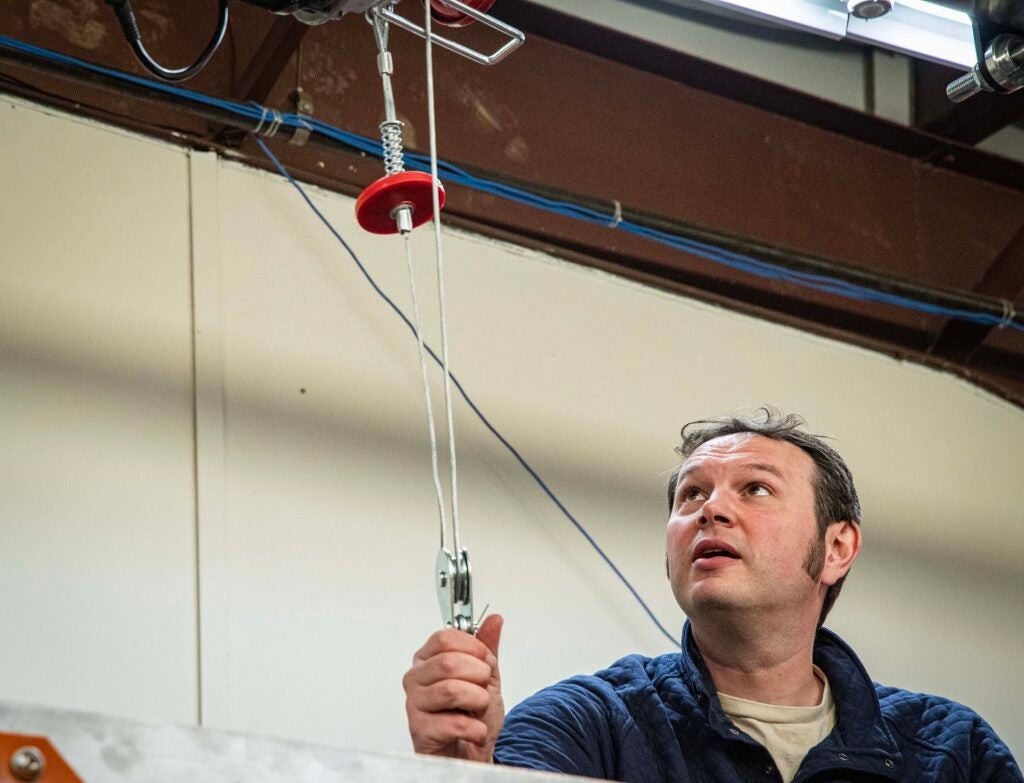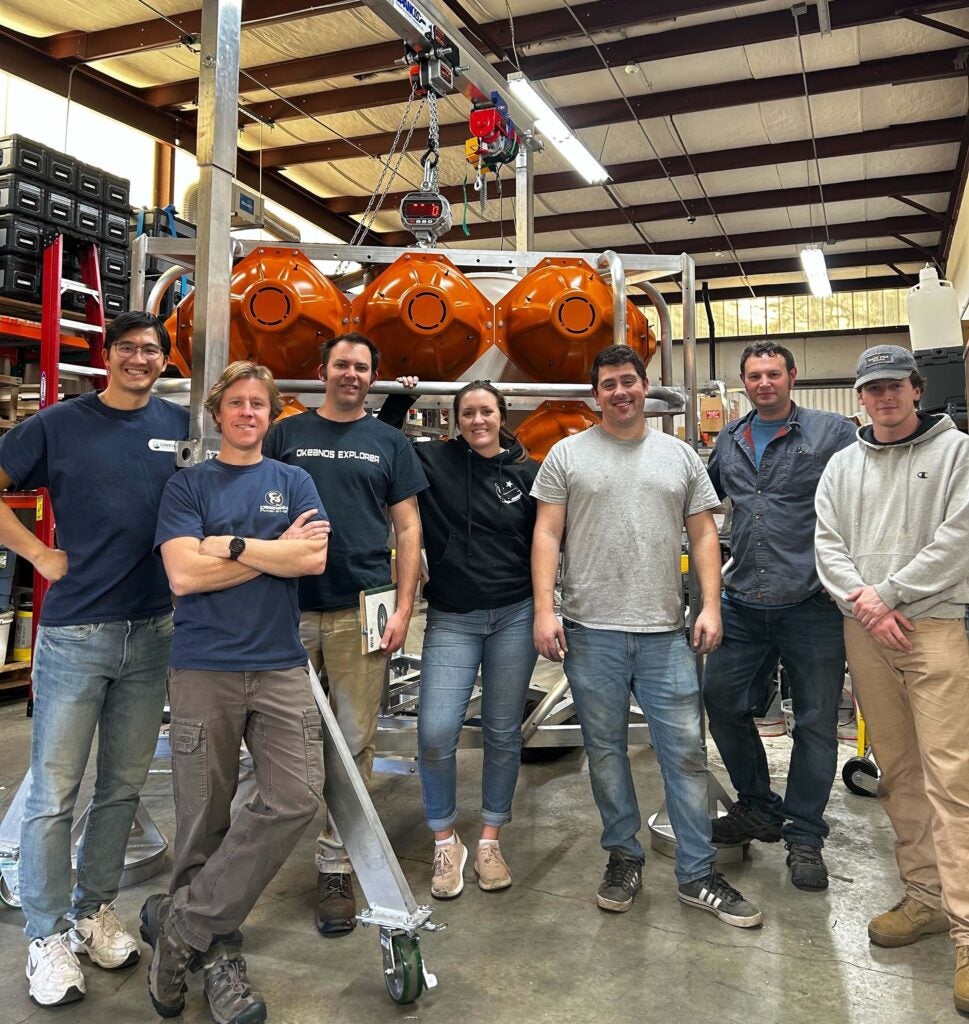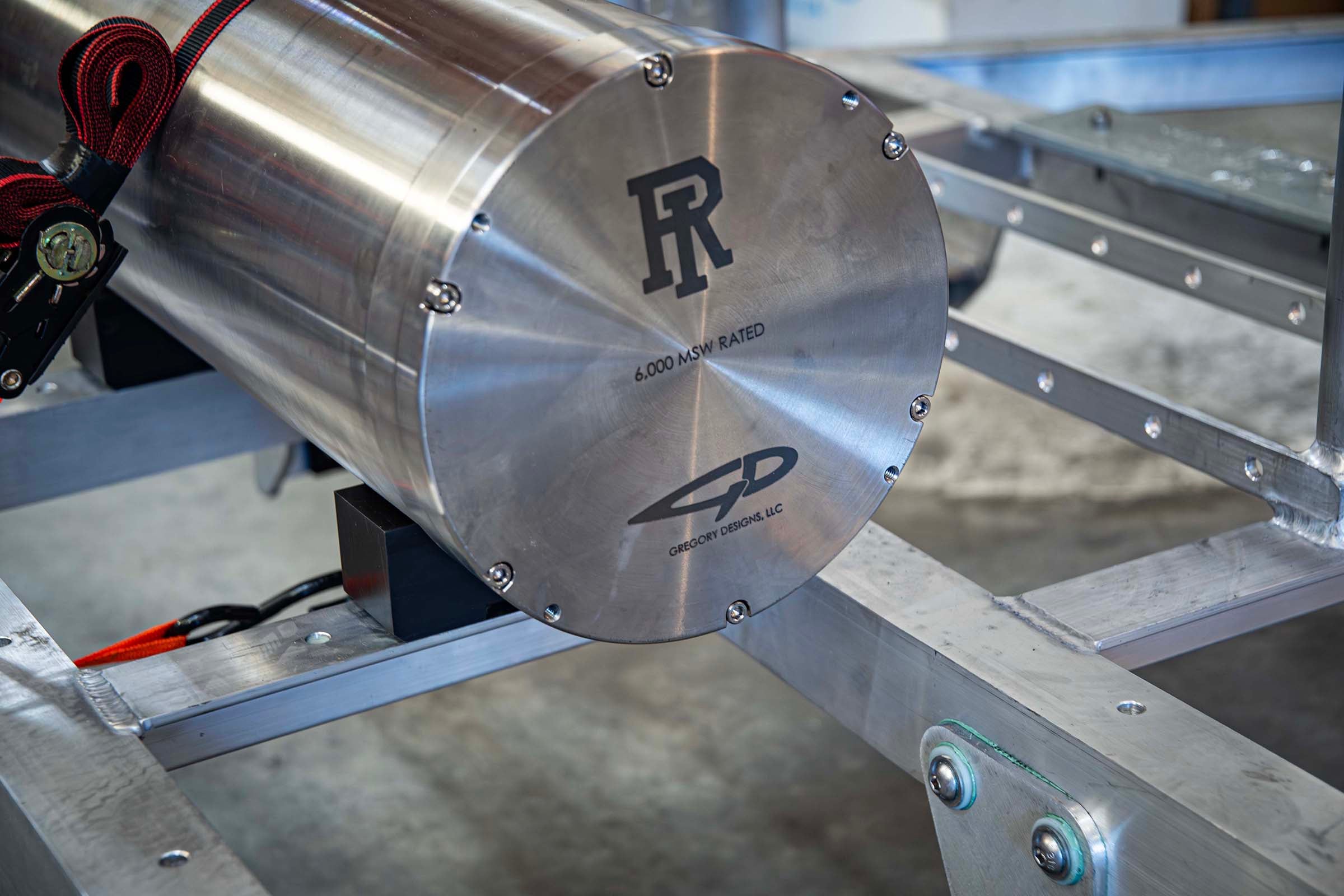KINGSTON, R.I. – Jan. 23, 2024 – A trip to the deep floor of the ocean is somewhat akin to going to the moon. Like the landers on the moon, a benthic lander can make it happen, just a little closer to home.
At the University of Rhode Island, a fleet of these observational systems is now taking shape, all being built at the University’s Narragansett Bay Campus, in preparation for their journey nearly two miles deep.
And yes, ‘benthic lander’ might sound like some kind of a new toy, but these large autonomous systems are designed to descend to the very bottom of the ocean where pressure and other stressors are extreme, and can be outfitted with a suite of oceanographic sensors, camera systems, and data loggers that provide valuable insights into the deep sea.

Once they are built, they will be greeted with excitement by Andrew Davies, professor in the College of the Environment and Life Sciences and the Graduate School of Oceanography, and his team of scientists and students.
A marine ecologist with a penchant for novel technologies, Davies is building a fleet of unmanned landers to explore the long-term recovery of deep-sea habitats affected by the 2010 Deepwater Horizon oil spill, the largest marine oil spill in U.S. history. The landers project has been funded by the National Oceanic and Atmospheric Administration (NOAA) and supported by the Ocean Exploration Cooperative Institute at URI.
A coral reef specialist, Davies and his team want to see how deep-sea coral reefs are faring today, over a decade since the spill in the Gulf of Mexico. Restoring these habitats is the focus of the Mesophotic and Deep Benthic Communities projects, led by NOAA and the Department of the Interior. Davies not only has expertise in the subject matter, but also in the means of getting to them, which was why NOAA approached him to lead this ambitious project.

Davies’ team hope to better understand the deep-sea environment by accessing it from a closer vantage point, by placing instruments close to biologically diverse deep-sea reefs, to better understand their response to disturbances, seasonal change, and changing food supplies.
A bigger, better lander
Observing the ocean is extremely challenging, especially offshore and in the deeper waters where the coral communities that Davies and his team study exist. “It is not cost- or resource-effective to keep a ship over an area of interest for a long period, but landers are one solution,” Davies says.
The landers being built at URI will provide observations for about a year at a time, filling in significant knowledge gaps and providing critical data on oceanographic conditions and activity in the Gulf, gathering necessary information for restoration and conservation in the area.
Designed to be released either at the surface or near the seafloor, through careful engineering that includes weighing each nut and bolt, the landers will fall to the seafloor and land gently in a target area, remaining there for as long as needed. When ready, Davies and his team will communicate with each lander, telling it when to come back to the surface.
Davies’ fleet of landers function as an instrument-rich ocean observatory, giving an unprecedented view of the environmental conditions that affect deep-sea communities within the Gulf of Mexico.
Davies has worked with all kinds of ocean landers in the course of his career; this new series will be his largest, most advanced and capable lander fleet yet, able to offer new clues into the deep-sea environment.
“To get this funding was a dream,” Davies says.
While his early career started with the study of teaspoon-size limpets, seaweeds and snails, at the water’s edge, once he moved to the deep ocean and larger forms of sea life, he hasn’t looked back. “The technical challenges and breathtaking species never cease to amaze me,” he comments.
Landing here
Davies has been on the faculty at URI for five years, bringing a background in biological oceanography with focus on reef-forming organisms and coastal issues such as climate change and pollution. But he modestly describes himself as a skilled jack-of-all-trades.
“I’m definitely a lander guy,” Davies says.
He first started working with landers in the mid-2000s in European waters. In those earlier days, landers were deployed and popped up above the waves with flapping orange flags to alert researchers to their oceanic whereabouts. Technology has advanced over the years, as has Davies’ knowledge. The new landers he’s overseeing today cost close to $300,000 each to design, build and instrument, and contain thousands of parts. “We are able to locate our landers to within ten feet in the ocean by integrating new tracking technologies; they really are quite special,” Davies says. It’s always been a dream to build his own series of landers to get closer to his subject of study and to delve deeper into the ecology of deep reef ecosystems, he adds.
“There is so much life down there but we know so little about it,” Davies says.
The new landers stand seven feet tall and are being entirely built at URI with appropriate, uniquely-sourced, ocean-safe materials that will provide years of valuable data that can be used by scientists and stakeholders interested in deep-sea ecology. Davies is also open to new collaborations, noting, “Our landers are designed to be highly versatile, so we can help other scientists conduct novel observations and experiments in the deep ocean.”
The students in his lab are benefiting from the opportunity to help build the landers, too.
“This type of work has accelerated my graduate experience,” says master’s student David Nadeau ’22, student engineer for the project. “The value of working on this project has been priceless. It is an extraordinary opportunity to be a student at the origin of a project as large as this. I have gathered invaluable experience working with Andy and other engineers on this project and know our work will benefit the lab, future students, and other scientists for years to come. We can’t wait to get them deployed.”
Measure twice, launch once
If going to the ocean floor is a little like going to the moon, such an expedition is also a journey into a beautiful but also hostile and unforgiving territory. Davies’ team will contend with the physical challenges of navigating and also the inhospitable nature of the ocean.
They are slated to ship the landers—carefully—to the Gulf of Mexico this year, launching this coming summer. After a year, they’ll be brought up, data downloaded and analyzed, and then serviced ready for their next mission to the deep.
“We all feel lucky to get to work on this,” Davies says.
Lab member Jane Carrick feels fortunate to be on the team and says seeing the landers built from the ground up has been a learning experience. She knows firsthand how valuable landers are from an end-user perspective because she is analyzing lander-collected data in her Ph.D. dissertation. She hopes to understand how critical deep-sea habitats are influenced by dynamic environmental conditions like water temperature, food supply, and currents.
“The amount of information that even a single lander can gather over one deployment can be field-advancing, so the fact that our team is contributing multiple landers to this and future projects makes me beyond proud to be a part of it,” she says.
“There aren’t many labs out there that would offer students the opportunity to actively participate in the planning and assembly of deep-sea landers. Learning firsthand all of the engineering and mechanical elements of our equipment is unequivocally improving my skill set and making me a better scientist. To see the landers through to their first deployments is going to be so much more exciting because our team made it happen.”


